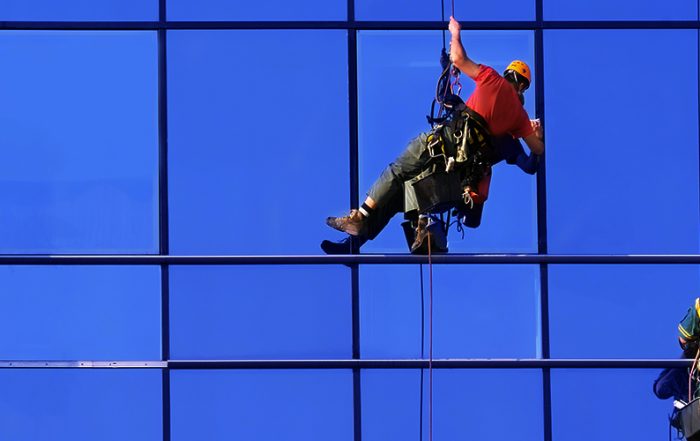The changing face of facilities management: Where is the sector heading?
While facilities management started from humble beginnings, it has now earned the respect of company executives as being instrumental in informing strategic decision-making, supporting financial targets and keeping operations running. So, what does the sector look like now? Where has it come from? And most importantly, where is it heading?
Introduction
It’s no exaggeration to say that facilities managers need to know something about everything. From building maintenance and environmental services, to catering, cleaning and space planning, they are tasked with an array of responsibilities. But, this hasn’t always been the case.
Facilities management (FM) as a profession and as a sector started as little more than caretaker and cleaning services in the 1970s, but it has evolved to become a discipline far greater – accepted as a key strategic element in any successful business.
So how has the sector grown and what does the future look like? Here we discuss three areas of focus and change and the new technologies supporting the growth of FM careers.
Focus 1: how is the FM role expanding? Changes in impact and scope
The contribution made by facilities managers to the successful operation of an organisation is frequently misunderstood and underestimated. The truth is that effective facilities management is vital for an organisation’s strategic and operational objectives.
By attending to record-keeping, ensuring compliance with regulations and maintaining assets, facilities managers can make the difference between success and failure. And that failure can be costly. In 2016, an investigation by Harlow Council uncovered six years of neglect by G4S Cash Solutions (UK) in managing its water systems, putting staff at risk of exposure to legionella. The company was subsequently fined £1.8 million.
Increasingly, the emphasis for facilities managers is shifting from purely asset management to supporting the health, wellbeing and comfort of employees. Working environments are now subject to tighter regulations, working practices have changed and staff wellbeing has become more of a focus – as a result, FMs today are accountable for how a workplace functions for its people, and not just the assets involved in powering the back-end processes.
Subsequently, facilities managers now play a key role in designing workplace experiences that communicate and reinforce organisational values. But, the design and maintenance of a workplace is not merely a cosmetic exercise. A recent study has revealed that 67% of workers claimed to have left their last job because of unsatisfactory office design, and 69% cited noise, poor lighting and access to quiet space as crucial factors affecting productivity. Facilities managers need to take account of this changing landscape, providing different types of office space to accommodate both quiet concentration and collaboration.
In addition, office space itself has become a more precious and expensive commodity – organisations now value premium buildings and spaces that offer the best value for money, the best impressions and the best environments. Cubicles and closed spaces have increasingly been replaced by modern workplaces that promote social collaboration, rising tech trends and comfort.
And as senior management continues to push the boundaries in terms of what they expect from their FM department, the whole industry
is required to mature at a similar rate to keep pace with changing visibility, expectations and demand. FMs need slick, modern software that can cater to the different elements of their now multi-faceted roles – replacing disparate systems, spreadsheets and workplace silos with central, effective platforms.
Role reversal – facilities managers as health and wellbeing advocates
At the beginning of 2017, Greg Davies, director of market development at Assurity Consulting forecast a bigger role for facilities managers in tackling occupational health issues: “From an FM perspective, this is all about how we develop and measure wellbeing. The HR issues are more about stress and mental health, but issues of the indoor environment quality – air quality, water quality, temperatures and humidity – they have a direct effect on productivity as well as wellbeing. How all of this is managed
and measured in the future is key.”
As such, the FM industry now has a firm foothold in driving organisations forward. An ageing population, advances in medical care and growing concerns about issues such as obesity and diabetes have important implications for the ways in which facilities managers approach their job. While facilities management professionals have longstanding experience of occupational health, the focus is shifting towards a wider role that takes in wellbeing and preventive measures.
Focus 2: How is the FM sector adapting? Changes in technology and trends
Using tech to triumph
The FM industry has met the same challenges as any other sector when it comes to technological advancement. While it’s come a long way since managing a facility manually with spreadsheets, tech adoption and efficiency still relies on the mentality of an organisation to want to change and do things differently. For most, the tech is there and so are the people – the challenge is how to combine the two constructively.
Facilities managers are deploying Computer Aided Facility Management (CAFM) software to manage and consolidate information across all facets of their responsibilities, from asset tracking to stock control, energy consumption to room bookings. Managing everything from one, central system has the obvious advantages of scalability, resource and time efficiencies and data transparency and management.
A key focus area for FM remains on mobile technology – people want to keep moving and digital tech needs to be able to cater to this. Senior management is hungry for performance data about how the workplace can operate more efficiently – but they want 24/7 access to it and flexibility in how it’s received. FM mobile technology presents a solution to this problem as demand increases.
However, there are signs that for facilities management – and the wider business services sector – the potential of technology has not been fully realised. A recent survey of property and facilities management professionals found that 75% of respondents believe themselves to be at the early stages of their technology journey. And while those already using technological solutions reported benefits concerning reporting, forecasting and compliance, only a small proportion believe they are currently harnessing technology successfully.
Budgetary constraints go some way towards explaining a tentative approach to adopting technological solutions. But, there is a need to publicise and promote how software can bring about cost savings, efficiency gains and profitability to catering, cleaning, security
and other functions under the facilities management umbrella.
Pushing technological boundaries
While the sector hasn’t always relied on technology, in a competitive, ever-changing environment, digital intervention is now the key to delivering a truly slick, efficient FM division. Growing expectations, workloads and demands mean that Outlook reminders and knowledge living solely in the heads of staff are no longer sufficient to support the needs of a modern day building or business. The benchmark has been raised.
Intelligent building management systems focus on more granular activity such as room bookings, and there is greater automation in data collection which can be used to inform asset replacement programmes, manage service contracts and understand the true cost of ownership.
RFID technology is another key development being introduced to the industry and incorporated in leading CAFM solutions. While RFID tracking is already used effectively across the health sector to manage the movement of equipment and medical records, the same principles can be applied to help FMs boost asset visibility and achieve a more holistic view of operations. By delivering this insight, teams are in a better position to identify multiple uses for assets and find ways for them to work together – not just in isolation.
What our
customers say
“FMs need slick, modern software that can cater to the different elements of their now multi-faceted roles – replacing disparate systems, spreadsheets and workplace silos with central, effective platforms.”
“A recent survey of property and facilities management professionals found that 75% of respondents believe themselves to be at the early stages of their technology journey.”
“As facilities management makes the transition from a buildingcentric to a user-centric profession, the skills demanded of facilities management professionals will need to reflect this new mandate.”

Focus 3: How is the FM workforce shifting? Changes in demographics and skill sets
Responding to a new generation
Doing more with less, managing rising costs, demonstrating value-for-money, keeping up with technological change – these are just some of the challenges facing facilities managers today. But perhaps the greatest challenge is responding to changes in the workforce, leading to a transformation of the facilities management profession itself, and a new demographic to serve.
Say hello to Generation Z.
Born between the 1990s and the present day, Generation Z share many of the characteristics of millennials, but have an identity of their own: “They are the early adopters, the brand influencers, the social media drivers, the pop-culture leaders. They comprise nearly two billion people globally, and they don’t just represent the future, they’re creating it.”
Accountancy firm Deloitte has forecast that this group will make up 75% of the global workforce by 2025. As this demographic grows in size and influence, employers are having to take account of the group’s associated values in order to attract and retain staff from this generation.
One of the world’s leading business services organisations has suggested that as facilities management makes the transition from a building-centric to a user-centric profession, the skills demanded of facilities management professionals will need to reflect this new mandate. As well as being compliance and service providers, facilities managers are taking on employee engagement roles to demonstrate their organisations’ commitment to sustainability and social responsibility – both of which are important themes for millennials, and for many other workers.
FM in a smarter, faster world
The world of work may be changing fast, but facilities management – and the technologies supporting it – are changing with it.
The role of FMs has always been a balancing act between policing and partnering. Monitoring compliance and maintaining property assets will continue to be important parts of the FM role. But, increasingly, FMs must partner with other workplace professionals to adopt a more holistic approach to employee well-being – and technology needs to play a fundamental role in helping to achieve that.
Ultimately, it will be the data and intelligence generated through technology that will help FMs work proactively to accelerate growth. Knowledge is power – and by using the insights collected in a more intelligent, profitable and efficient way, the industry has the potential to have an even bigger impact on driving both organisations and workforces forward. Further integration with the Internet of Things, cloud migration and hosting and tech concepts as far-reaching as speech recognition and augmented reality could present the next phase of facilities management.
But the biggest challenge for the facilities managers of today and tomorrow will be to ensure they can maintain both a leadership and operational role, while adapting to a workplace and sector that is continually being redefined. That’s why for those FMs who want to take charge and stay on the front foot without time to wait, technology will be their best friend.




